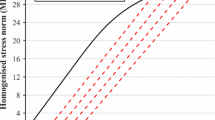Abstract
An iterative procedure for the stress analysis at interfaces between dissimilar materials is presented. The problem is specialised to the case of biomaterial interfaces with particular reference to materials which are characterised by tiny microstructures. The procedure is based on a recursive analysis of small size problems defined upon subdomains obtained by partitioning the whole structural domain. The kinematic boundary conditions are iteratively adjusted by using appropriate preconditioners. The numerical example reported in this paper shows that the procedure is effective regardless of the degree of material heterogeneity, in contrast with the results obtained by using a coarse mesh for the whole domain. The procedure seems to be a promising one for determining the structural strength of interfaces between trabecular bone and metal implants requiring accurate evaluation of stress at the scale level of the single microstructure exhibited by the bone.
Similar content being viewed by others
References
Charras, G.T. and Guldberg, R.E., ‘Improving the local solution accuracy of large-scale digital image-based finite element analyses’, J. Biomech. 33 (2000) 255-259.
Jacobs, C.R., Davis, B.R., Rieger, C.J., Francis, J.J., Saad, M. and Fyhrie, D.P., ‘The impact of boundary conditions and mesh size on the accuracy of cancellous bone tissue modulus determination using large-scale finite-element modeling’, J. Biomech. 32 (1999) 1159-1164.
Pistoia, W., van Rietbergen, B., Laib, A. and Ruegsegger, P., ‘High-resolution three-dimensional pQCT images can be an adequate basis for in vivo microFE analysis of bone’, J. Biomech. Eng. 123(2) (2001) 176-183.
Niebur, G.L., Feldstein, M.J., Yuen, J.C., Chen, T.J. and Keaveny, T.M., ‘High-resolution finite element models with tissue strength asymmetry accurately predict failure of trabecular bone’, J. Biomech. 33(12) (2000) 1575-1583.
Guldberg, R.E., Hollister, S.J. and Charras, G.T., ‘The accuracy of digital image-based finite element models’, J. Biomech. Eng. 120(2) (1998) 289-295.
Le Tallec, P., ‘Domain decomposition methods in computational mechanics’, Comput. Mech. Adv. 1 (1994) 121-220.
Wentorf, R., Collar, R., Shephard, M.S. and Fish, J., ‘Automated modeling for complex woven mesostructures’, Comput. Meth. Appl. Mech. Eng. 172 (1999) 273-291.
Zohdi, T.I., Oden, J.T. and Rodin, G.J., ‘Hierarchical modeling of heterogeneous solids’, Comput. Meth. Appl. Mech. Eng. 172 (1999) 3-25.
Terada, K., Hori, M., Kyoya, T. and Kikuchi, N., ‘Simulation of the multi-scale convergence in computational homogenisation approaches’, Int. J. Solids Struct. 37 (2000) 2285-2311.
Author information
Authors and Affiliations
Rights and permissions
About this article
Cite this article
Vena, P., Contro, R. Micromechanical Analysis of the Trabecular Bone Stress State at the Interface with Metallic Biomedical Devices* . Meccanica 37, 431–439 (2002). https://doi.org/10.1023/A:1020852108109
Issue Date:
DOI: https://doi.org/10.1023/A:1020852108109




